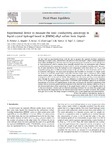Experimental Device to Measure the Ionic Conductivity Anisotropy in Liquid Crystal Hydrogel Based In [EMIM] Alkyl Sulfate Ionic Liquids

Use este enlace para citar
http://hdl.handle.net/2183/30029
Excepto si se señala otra cosa, la licencia del ítem se describe como Atribución-NoComercial-SinDerivadas 4.0 Internacional
Colecciones
- Investigación (FCIE) [1228]
Metadatos
Mostrar el registro completo del ítemTítulo
Experimental Device to Measure the Ionic Conductivity Anisotropy in Liquid Crystal Hydrogel Based In [EMIM] Alkyl Sulfate Ionic LiquidsAutor(es)
Fecha
2021-12-10Cita bibliográfica
D. Portela, L. Segade, Y. Arosa, E. López Lago, L.M. Varela, E. Tojo, O. Cabeza, Experimental device to measure the ionic conductivity anisotropy in liquid crystal hydrogel based in [EMIM] alkyl sulfate Ionic Liquids, Fluid Phase Equilibria. 555 (2022) 113353. https://doi.org/10.1016/j.fluid.2021.113353
Resumen
[Abstract] We have built an experimental device with the aim to measure the expected electrical conductivity anisotropy in a liquid crystal, obtained from the gelation of the ionic liquid 1-ethyl-3-methyl imidazolium decyl sulfate, [EMIM][DSO4]. This ionic liquid has the particularity that it transits to a semi-solid gel state at room temperature when it contains water, naturally adsorbed from the environment until a balance is reached between the concentration of water in the IL and the atmospheric humidity grade. The quantity of water adsorbed to form the hydrogel at room temperature varies from about 5 to 30 wt%, each composition giving place to different smectic phases. In the gel state, the ionic liquid ions and the water molecules self-organize into micro-sized mesophases that resemble the structures of a liquid crystal. Our device is a closed 2D sample holder (with sides 150 times longer than its thickness), with a single narrow window open to the atmosphere, and four copper contacts on the sides. The dried ionic liquid is tempered at 40 °C to increase its fluidity when injected into the cavity, and then, it can only adsorb water through the narrow opening. Thus, water adsorption is unidirectional and slow, so the transition of the IL to the gel phase happens progressively. A metastable giant mesophase appears as an orientated macrodomain in the form of a striped pattern. In this state, we measure the electrical conductivity of the confined film in directions parallel and perpendicular to the observed strips, finding a difference of up to 26% between both values of the conductivity. If the sample freezes (below 10 °C) or it liquefies (above 50 °C) the meso structure is broken and the observed anisotropy destroyed. We can return the sample to gel state by varying the temperature, but the ordered macroscopic state is no longer recovered. This research must give clues to solve the charge transport mechanism quiz in ionic liquids and semi-solid coductors.
Palabras clave
2D experimental device
Ionic liquid
Hydrogel
Electrical conductivity
Anisotropy
Liquid crystal
Ionic liquid
Hydrogel
Electrical conductivity
Anisotropy
Liquid crystal
Descripción
Financiado para publicación en acceso aberto: Universidade da Coruña/CISUG
Versión del editor
Derechos
Atribución-NoComercial-SinDerivadas 4.0 Internacional
ISSN
0378-3812






